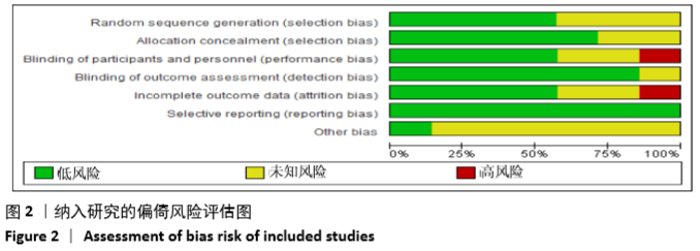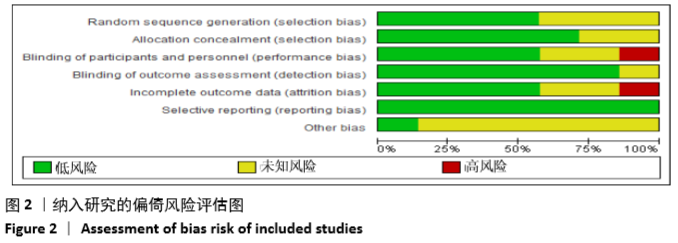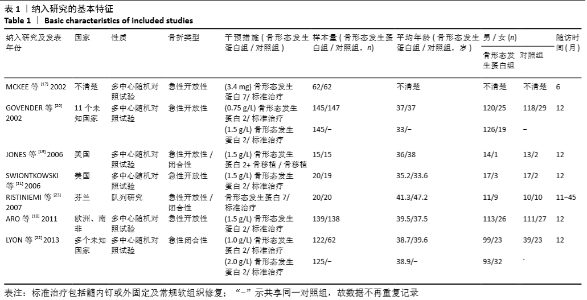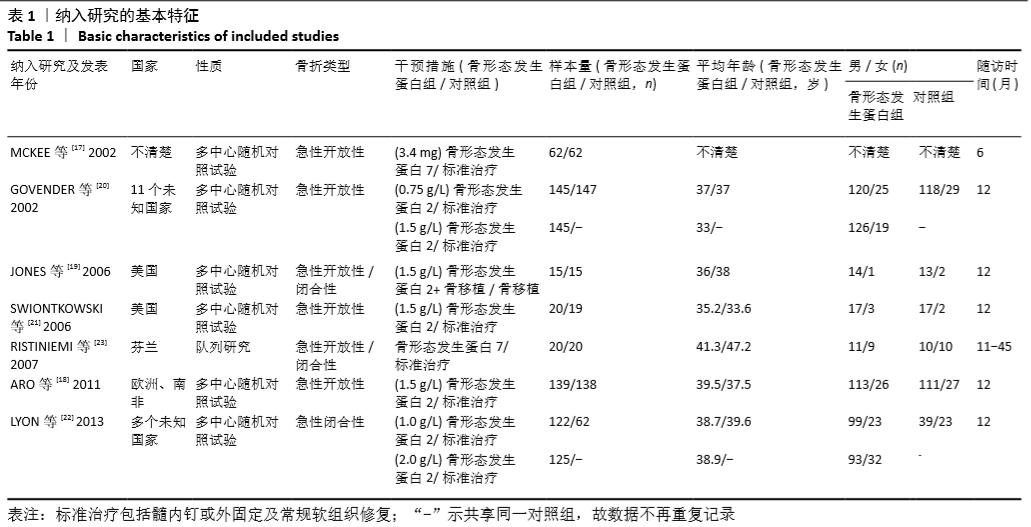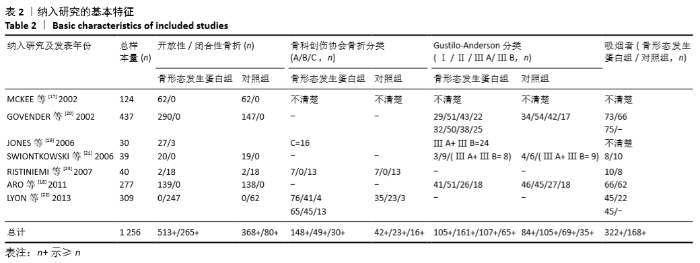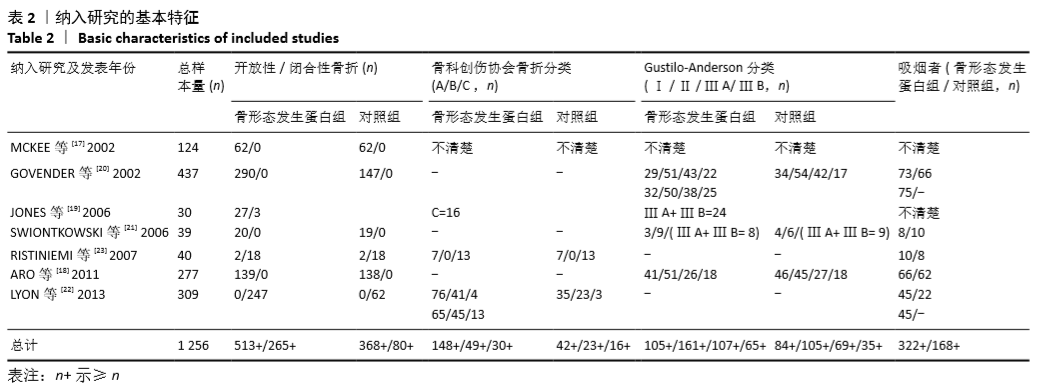Chinese Journal of Tissue Engineering Research ›› 2021, Vol. 25 ›› Issue (3): 486-492.doi: 10.3969/j.issn.2095-4344.2944
Systematic review and meta-analysis of bone morphogenetic protein for the treatment of acute tibial fracture
Xie Chengxin1, Wang Wei1, Wang Chenglong2, Li Qinglong2, Yin Dong2
- 1Graduate School of Guangxi University of Chinese Medicine, Nanning 530200, Guangxi Zhuang Autonomous Region, China; 2Department of Orthopedics, People’s Hospital of Guangxi Zhuang Autonomous Region, Nanning 530021, Guangxi Zhuang Autonomous Region, China
-
Received:2020-03-09Revised:2020-03-13Accepted:2020-04-03Online:2021-01-28Published:2020-11-19 -
Contact:Yin Dong, MD, Master’s supervisor, Chief physician, Department of Orthopedics, People’s Hospital of Guangxi Zhuang Autonomous Region, Nanning 530021, Guangxi Zhuang Autonomous Region, China -
About author:Xie Chengxin, Master candidate, Graduate School of Guangxi University of Chinese Medicine, Nanning 530200, Guangxi Zhuang Autonomous Region, China -
Supported by:Innovation Project of Guangxi Graduate Education, No. YCSW2020188
CLC Number:
Cite this article
Xie Chengxin, Wang Wei, Wang Chenglong, Li Qinglong, Yin Dong. Systematic review and meta-analysis of bone morphogenetic protein for the treatment of acute tibial fracture[J]. Chinese Journal of Tissue Engineering Research, 2021, 25(3): 486-492.
share this article
Add to citation manager EndNote|Reference Manager|ProCite|BibTeX|RefWorks
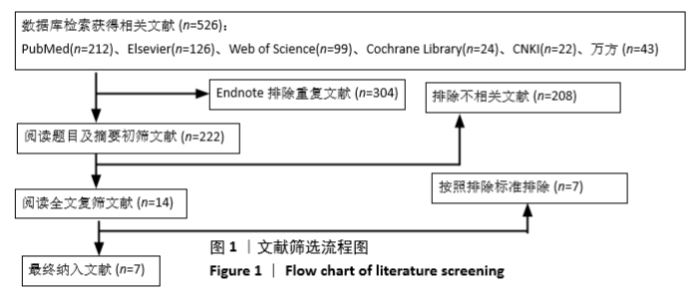
2.1 文献检索结果及质量评价 根据检索策略共检索出526篇可能符合纳入标准的文献,并导入到Endnote X9中进行重复文献的排除,剩余222篇相关文献。然后根据题目、摘要的内容,排除不相关的文献208篇,初步筛选后得到14篇。通过仔细阅读全文,严格按照纳入及排除标准,再次排除文献7篇(研究对象未符合标准2篇,干预措施不符2篇,数据不全1篇,重复发表文献2篇),最终纳入7篇文献进行Meta分析[17-23],筛选流程见图1。其中6篇为随机对照研究[17-22],1篇为队列研究[23],共计1 256例病例,包括骨形态发生蛋白组793例,对照组463例。纳入文献质量评价及风险评估结果见图2,纳入研究的基本特征见表1,2。"
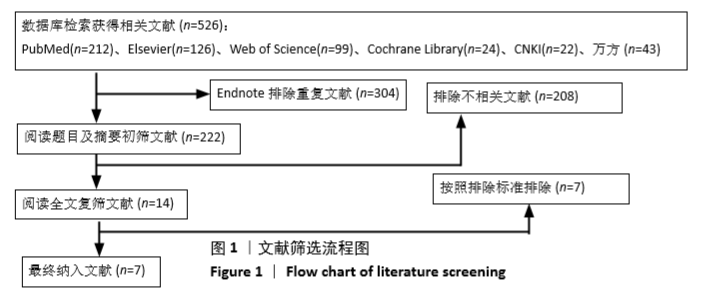

2.2.1 术后愈合率 6篇文献报道了骨愈合率[17-20,22-23]。异质性检验提示各研究间存在较高异质性(I2=59%,P=0.02),故采用随机效应模型。Meta分析结果显示,骨形态发生蛋白组与对照组愈合率比较差异无显著性意义[RR=1.11,95%CI(0.99,1.25),P=0.07],但可观察到骨形态发生蛋白具有利于骨折愈合的趋势,见图3。敏感性分析结果显示,分别单独剔除Govender(2002b)等[20]和Lyon(2013b)等[22]的研究后,异质性均有所减小(I2=45%和I2=42%)。其中,剔除Lyon(2013b)等[22]的研究后Meta分析结果发生改变[RR=1.14,95%CI(1.02,1.28),P=0.02]。分析原因可能是:①Lyon(2013b)等[22]的研究中患者骨折类型均为闭合性,骨缺损及软组织损伤程度较开放性轻,相比之下骨形态发生蛋白的成骨优势并不明显;②该研究采用的骨形态发生蛋白载体(磷酸钙基质)和其他文献(可吸收胶原海绵)报道的不同,载体的劣势导致骨形态发生蛋白的生物利用度较低;③该研究中骨形态发生蛋白的剂量(2.0 g/L)较高,使用高剂量的骨形态发生蛋白伴随着并发症增加的风险,一定程度上会对骨折愈合产生消极影响。"


考虑骨形态发生蛋白的剂量不同对结果的影响,故纳入其中3篇剂量为1.5 g/L的研究进行合并分析[18-20]。但Meta分析结果无明显改变,2组的愈合率比较差异无显著性意义[RR=1.19,95%CI(0.95,1.49),P=0.13]。 对3篇仅包含开放性骨折的研究进行Meta分析[17-18, 20],异质性检验提示存在不明显异质性(I2=27%,P=0.25),故采用固定效应模型。结果显示骨形态发生蛋白组的愈合率显著高于对照组[RR=1.16,95%CI(1.04,1.30),P=0.009],2组愈合率分别为64.4%(316/491)和58.5%(203/347),见图4。表明应用骨形态发生蛋白能够提高急性胫骨开放性骨折的愈合率。"


2.2.7 异位骨化及软组织钙化率 4篇文献提供了异位骨化及软组织钙化的具体数据[18-19,22-23]。各研究间无统计学异质性(I2=0%,P=0.46),故采用固定效应模型。Meta分析结果显示,骨形态发生蛋白组较对照组具有更高的异位骨化及软组织钙化率[RR=2.89,95%CI(1.40,5.95),P=0.004],2组发生率分别为13.8%(58/421)和3.8%(9/235),见图10。此外,Govender等[20]的研究结果表示,在标准护理中添加骨形态发生蛋白不会增加偏远部位局部软组织钙化或异位骨化的发生率。然而,该研究没有提供具体数据,故未能纳入此次Meta分析。 2.2.8 骨折愈合时间 4篇文献对骨折愈合时间进行了相关描述[18, 20,22-23],但由于缺乏详细数据,未能进行合并分析。GOVENDER等[20]的研究报道,1.5 g/L骨形态发生蛋白组骨折愈合时间明显短于对照组(P=0.002 2),其50%患者骨折愈合时间相比对照组缩短39 d;RISTINIEMI等[23]的研究中,骨形态发生蛋白组的愈合时间明显短于对照组(P=0.002),骨折愈合的患者在16周(P=0.039)和20周(P=0.022)均明显多于对照组;ARO等[18]的结果显示术后13周骨形态发生蛋白组的骨折愈合率高于对照组(60% vs. 48%),但未达到统计学差异(P=0.054 1);LYON等[22]的研究则表明两者在骨折愈合时间方面差异无显著性意义(P=0.476)。"

| [1] Li Y, Shen S, Xiao Q, et al. Efficacy comparison of double-level and single-level bone transport with Orthofix fixator for treatment of tibia fracture with massive bone defects. Int Orthop. 2020;44(5):957-963. [2] Wuarin L, Gonzalez AI, Zingg M, et al. Clinical and radiographic predictors of acute compartment syndrome in the treatment of tibial shaft fractures: a retrospective cohort study. BMC Musculoskelet Disord. 2020;21(1):1-11. [3] Meinberg E, Agel J, Roberts C, et al. Fracture and dislocation classification compendium-2018. J Orthop Trauma. 2018;32:S1-S10. [4] Kim P. Leopold S. Gustilo-anderson classification. Clin Orthop Relat Res.2012; 470(11): 3270-3274. [5] Lua J, Tan V, Sivasubramanian H, et al. Complications of open tibial fracture management: risk factors and treatment. Malays Orthop J. 2017;11(1):18-22. [6] Singaram S, Naidoo M. The physical, psychological and social impact of long bone fractures on adults: A review. Afr J Prim Health Care Fam Med. 2019;11(1):e1-e9. [7] Ghodadra N, Singh K. Recombinant human bone morphogenetic protein-2 in the treatment of bone fractures. Biologics. 2008;2(3):345-354. [8] Itoi T, Harada Y, Irie H, et al. Escherichia coli-derived recombinant human bone morphogenetic protein-2 combined with bone marrow-derived mesenchymal stromal cells improves bone regeneration in canine segmental ulnar defects. BMC Vet Res.2016;12:201. [9] Poon B, Kha T, Tran S, et al. Bone morphogenetic protein-2 and bone therapy: successes and pitfalls. J Pharm Pharmacol. 2016;68(2):139-147. [10] Morris R, Pallister I, Trickett RW. Measuring outcomes following tibial fracture. Injury.2019;50(2):521-533. [11] Fisher M, Yee K, Alba B, et al. Applications of Bone Morphogenetic Protein-2: Alternative Therapies in Craniofacial Reconstruction. J Craniofac Surg. 2019;30(7):1952-1959. [12] Richards BS, Anderson TD. RhBMP-2 and intramedullary fixation in congenital pseudarthrosis of the tibia. J Pediatr Orthop. 2018;38(4):230-238. [13] Dai J, Li L, Jiang C, et al. Bone morphogenetic protein for the healing of tibial fracture: a meta-analysis of randomized controlled trials. PLoS One. 2015;10(10):e0141670. [14] 魏攀登, 曹立颖, 丁明聪, 等. 骨形态发生蛋白治疗开放性胫骨骨折的Meta分析[J]. 中国骨伤,2012,25(11):946-950. [15] Wei S, Cai X, Huang J, et al. Recombinant human BMP-2 for the treatment of open tibial fractures. Orthopedics. 2012; 35(6): e847-e854. [16] Barcak EA, Beebe MJ. Bone Morphogenetic Protein: is there still a role in orthopedic trauma in 2017? OrthopClin North Am. 2017; 48(3):301-309. [17] McKee M, Schemitsch E, Waddell J, et al. The effect of human recombinant bone morphogenic protein (rhBMP-7) on the healing of open tibial shaft fractures: results of a multi-center, prospective, randomized clinical trial. Proceedings of the 18th annual meeting of the orthopaedic trauma association. Toronto: 11-13. [18] Aro HT, Govender S, Patel AD, et al. Recombinant human bone morphogenetic protein-2: a randomized trial in open tibial fractures treated with reamed nail fixation. J Bone Joint Surg Am. 2011;93(9):801-808. [19] Jones AL, Bucholz RW, Bosse MJ, et al. Recombinant human BMP-2 and allograft compared with autogenous bone graft for reconstruction of diaphysealtibial fractures with cortical defects. A randomized, controlled trial. J Bone Joint Surg Am. 2006;88(7):1431-1441. [20] Govender S, Csimma C, Genant HK, et al. Recombinant human bone morphogenetic protein-2 for treatment of open tibial fractures: a prospective, controlled, randomized study of four hundred and fifty patients. J Bone Joint Surg Am. 2002;84-A(12): 2123-2134. [21] Swiontkowski MF, Aro HT, Donell S, et al. Recombinant human bone morphogenetic protein-2 in open tibial fractures. A subgroup analysis of data combined from two prospective randomized studies. J Bone Joint Surg Am. 2006;88(6):1258-1265. [22] Lyon T, Scheele W, Bhandari M, et al. Efficacy and safety of recombinant human bone morphogenetic protein-2/calcium phosphate matrix for closed tibialdiaphyseal fracture: a double-blind, randomized, controlled phase-II/III trial. J Bone Joint Surg Am. 2013;95(23): 2088-2096. [23] Ristiniemi J, Flinkkila T, Hyvonen P, et al. RhBMP-7 accelerates the healing in distal tibial fractures treated by external fixation. J Bone Joint Surg Br. 2007;89(2):265-272. [24] Hao ZC, Xia Y, Xia DM, et al. Treatment of open tibialdiaphyseal fractures by external fixation combined with limited internal fixation versus simple external fixation: a retrospective cohort study. BMC Musculoskelet Disord. 2019;20(1):311. [25] Ribeiro FO, Gómez-Benito MJ, Folgado J, et al. Insilicomechano-chemical model of bone healing for the regeneration of critical defects: the effect of BMP-2. PLoS One. 2015;10(6):e0127722. [26] Singh R, Bleibleh S, Kanakaris NK, et al. Upper limb non-unions treated with BMP-7: efficacy and clinical results. Injury. 2016;47 Suppl 6:S33-S39. [27] Hissnauer TN, Stiel N, Babin K, et al. Recombinant human bone morphogenetic protein-2 (rhbmp-2) for the treatment of nonunion of the femur in children and adolescents: a retrospective analysis. Biomed Res Int. 2017;2017: 3046842. [28] 耿彬, 陈永刚, 夏亚一, 等. 骨形态生成蛋白治疗骨折的系统评价[J]. 中国矫形外科杂志, 2010,18(23):1949-1954. [29] Harris I, Lyons M. Reoperation rate in diaphyseal tibia fractures. ANZ J Surg. 2005; 75(12):1041-1044. [30] Papanagiotou M, Dailiana ZH, Karachalios T, et al. Heterotopic ossification after the use of recombinant human bone morphogenetic protein-7. World J Orthop. 2017;8(1):36-41. [31] Shi L, Sun W, Gao F, et al. Heterotopic ossification related to the use of recombinant human BMP-2 in osteonecrosis of femoral head. Medicine (Baltimore). 2017;96(27):e7413. [32] Kwak EJ, Cha IH, Nam W, et al. Effects of locally administered rhBMP-2 and bisphosphonate on bone regeneration in the rat fibula. Oral Dis.2018;24(6):1042-1056. [33] Cannada LK. A randomized controlled trial comparing rhbmp-2/acs vs. autograft for the treatment of tibia fractures with critical size defects. J Orthop Trauma. 2019;33(8):384-391. [34] Alt V, Donell ST, Chhabra A, et al. A health economic analysis of the use of rhBMP-2 in Gustilo-Anderson grade III open tibial fractures for the UK, Germany, and France. Injury. 2009;40(12):1269-1275. |
| [1] | Hu Kai, Qiao Xiaohong, Zhang Yonghong, Wang Dong, Qin Sihe. Treatment of displaced intra-articular calcaneal fractures with cannulated screws and plates: a meta-analysis of 15 randomized controlled trials [J]. Chinese Journal of Tissue Engineering Research, 2021, 25(9): 1465-1470. |
| [2] | Huang Dengcheng, Wang Zhike, Cao Xuewei. Comparison of the short-term efficacy of extracorporeal shock wave therapy for middle-aged and elderly knee osteoarthritis: a meta-analysis [J]. Chinese Journal of Tissue Engineering Research, 2021, 25(9): 1471-1476. |
| [3] | Xu Feng, Kang Hui, Wei Tanjun, Xi Jintao. Biomechanical analysis of different fixation methods of pedicle screws for thoracolumbar fracture [J]. Chinese Journal of Tissue Engineering Research, 2021, 25(9): 1313-1317. |
| [4] | Jiang Yong, Luo Yi, Ding Yongli, Zhou Yong, Min Li, Tang Fan, Zhang Wenli, Duan Hong, Tu Chongqi. Von Mises stress on the influence of pelvic stability by precise sacral resection and clinical validation [J]. Chinese Journal of Tissue Engineering Research, 2021, 25(9): 1318-1323. |
| [5] | Zhang Tongtong, Wang Zhonghua, Wen Jie, Song Yuxin, Liu Lin. Application of three-dimensional printing model in surgical resection and reconstruction of cervical tumor [J]. Chinese Journal of Tissue Engineering Research, 2021, 25(9): 1335-1339. |
| [6] | Zhang Yu, Tian Shaoqi, Zeng Guobo, Hu Chuan. Risk factors for myocardial infarction following primary total joint arthroplasty [J]. Chinese Journal of Tissue Engineering Research, 2021, 25(9): 1340-1345. |
| [7] | Wei Wei, Li Jian, Huang Linhai, Lan Mindong, Lu Xianwei, Huang Shaodong. Factors affecting fall fear in the first movement of elderly patients after total knee or hip arthroplasty [J]. Chinese Journal of Tissue Engineering Research, 2021, 25(9): 1351-1355. |
| [8] | Wang Jinjun, Deng Zengfa, Liu Kang, He Zhiyong, Yu Xinping, Liang Jianji, Li Chen, Guo Zhouyang. Hemostatic effect and safety of intravenous drip of tranexamic acid combined with topical application of cocktail containing tranexamic acid in total knee arthroplasty [J]. Chinese Journal of Tissue Engineering Research, 2021, 25(9): 1356-1361. |
| [9] | Xiao Guoqing, Liu Xuanze, Yan Yuhao, Zhong Xihong. Influencing factors of knee flexion limitation after total knee arthroplasty with posterior stabilized prostheses [J]. Chinese Journal of Tissue Engineering Research, 2021, 25(9): 1362-1367. |
| [10] | Huang Zexiao, Yang Mei, Lin Shiwei, He Heyu. Correlation between the level of serum n-3 polyunsaturated fatty acids and quadriceps weakness in the early stage after total knee arthroplasty [J]. Chinese Journal of Tissue Engineering Research, 2021, 25(9): 1375-1380. |
| [11] | Zhang Chong, Liu Zhiang, Yao Shuaihui, Gao Junsheng, Jiang Yan, Zhang Lu. Safety and effectiveness of topical application of tranexamic acid to reduce drainage of elderly femoral neck fractures after total hip arthroplasty [J]. Chinese Journal of Tissue Engineering Research, 2021, 25(9): 1381-1386. |
| [12] | Wang Haiying, Lü Bing, Li Hui, Wang Shunyi. Posterior lumbar interbody fusion for degenerative lumbar spondylolisthesis: prediction of functional prognosis of patients based on spinopelvic parameters [J]. Chinese Journal of Tissue Engineering Research, 2021, 25(9): 1393-1397. |
| [13] | Lü Zhen, Bai Jinzhu. A prospective study on the application of staged lumbar motion chain rehabilitation based on McKenzie’s technique after lumbar percutaneous transforaminal endoscopic discectomy [J]. Chinese Journal of Tissue Engineering Research, 2021, 25(9): 1398-1403. |
| [14] | Chen Xinmin, Li Wenbiao, Xiong Kaikai, Xiong Xiaoyan, Zheng Liqin, Li Musheng, Zheng Yongze, Lin Ziling. Type A3.3 femoral intertrochanteric fracture with augmented proximal femoral nail anti-rotation in the elderly: finite element analysis of the optimal amount of bone cement [J]. Chinese Journal of Tissue Engineering Research, 2021, 25(9): 1404-1409. |
| [15] | Du Xiupeng, Yang Zhaohui. Effect of degree of initial deformity of impacted femoral neck fractures under 65 years of age on femoral neck shortening [J]. Chinese Journal of Tissue Engineering Research, 2021, 25(9): 1410-1416. |
| Viewed | ||||||
|
Full text |
|
|||||
|
Abstract |
|
|||||
